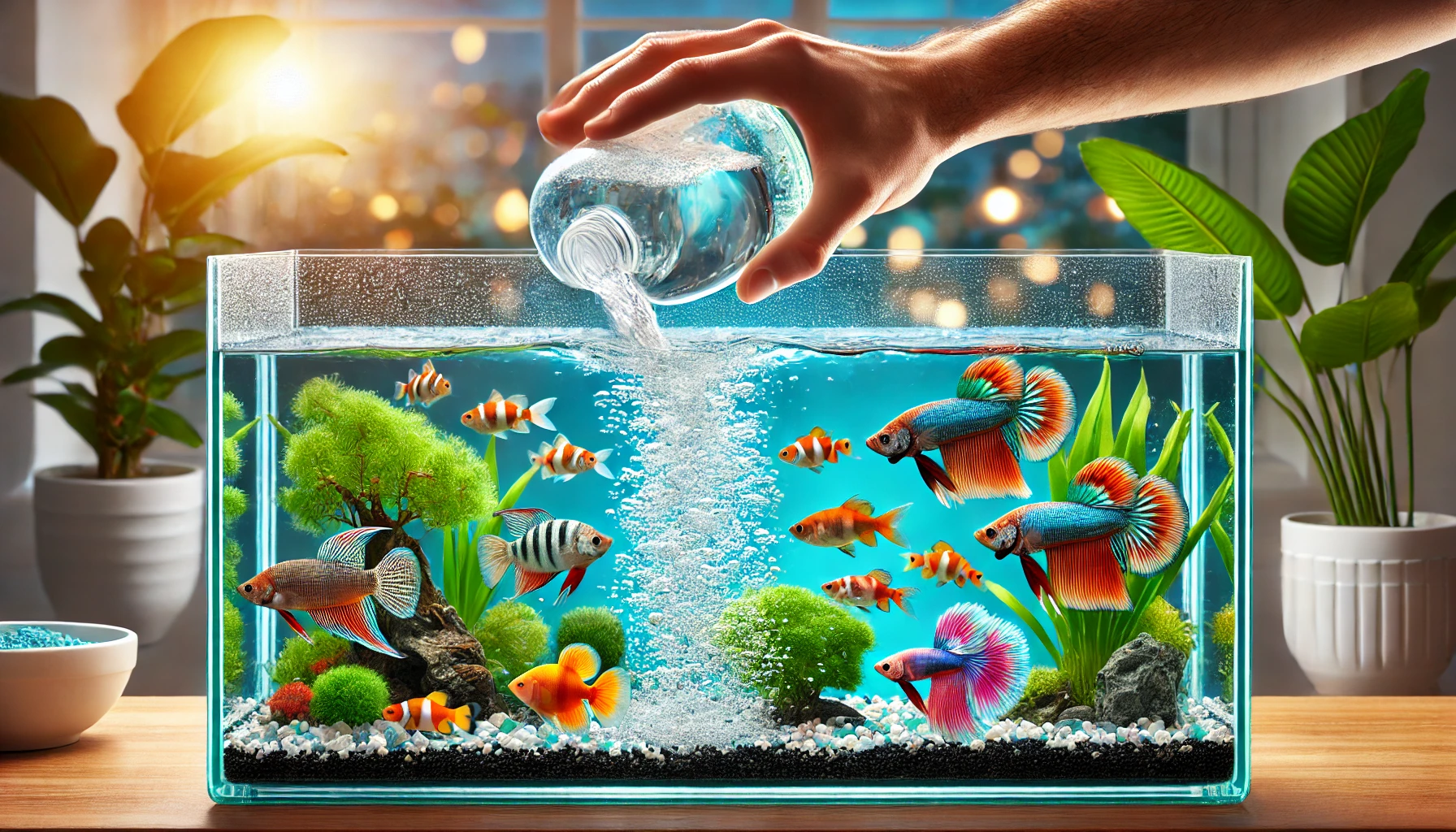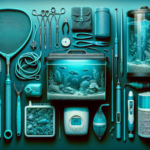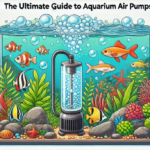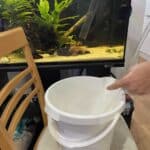The art of keeping fish healthy is not in fish keeping, but in keeping good quality water. From time to time, this will require the changing of a small percentage of old water with new, or topping up of water levels after noticeable evaporation has occurred. If using chlorinated water from your household tap, or from a water source that may contain heavy metals, it will be important to treat your water with a water conditioner before adding it to your tank to keep your fish safe.
What Is a Fish Tank Water Conditioner and Why Do You Need It?
In short, a fish tank water conditioner is a solution designed to make tap water safe for aquarium inhabitants, this includes the fish, invertibrates and also the beneficial bacteria living in your filter. Tap water often contains chlorine, chloramine, and heavy metals. These elements are added during municipal water treatment to eliminate harmful bacteria, and keep water safe for us humans to consume. The catch here though it that these additional elements can be toxic to fish and other aquatic life. Water conditioners neutralize these harmful substances, making the water safe to add to your fish tank.
How Does a Fish Tank Water Conditioner Work?
Water conditioners perform several functions to detoxify tap water:
Neutralizing Chlorine and Chloramine
Chlorine is commonly used to disinfect tap water, just like in a swimming pool, but in much lower doses in our drinking water. Water conditioners use agents such as sodium thiosulfate to convert toxic chlorine into non-toxic chloride through a chemical reaction.
Chloramine, a more stable compound of chlorine and ammonia, requires a two-step process to neutralize both components effectively. To detoxify chloramines, the bond is first broken between the chlorine and ammonia molecules. The former is removed by the above process. The latter can be left to be used by the beneficial bacteria in your tank, as part of the nitrogen cycle.
These days, a number of water conditioners also contain a chemical such as sodium hydroxymethanesulfonate, which converts the ammonia into ammonium – a form that can still be used by the benefical bacteria in your tank, but is far less toxic to fish.
Detoxifying Heavy Metals and Ammonia
Tap water can contain heavy metals such as lead and copper, which are also toxic to fish. Some advanced water conditioners contain chelating agents like EDTA (ethylenediaminetetraacetic acid), which bind to heavy metals and neutralize their toxicity. The metals remain in the water but in a non-toxic form that won’t harm fish.
Protecting Fish with Slime Coat Additives
Some water conditioners include additives like aloe vera that promote the production of a fish’s natural slime coat. This protective layer acts as a barrier against pathogens and helps to reduce stress, enhancing the overall health of your fish. This is not needed all the time, but can be useful to have on hand during certain times, such as injury, adding new fish, moving fish.
How to Use a Water Conditioner in Your Fish Tank
Step-by-Step Guide for Beginners
Read the Instructions: Always follow the manufacturer’s guidelines for dosage and application.
Prepare the Water: Before adding replacement water from the tap to your tank, treat it with the appropriate amount of conditioner in a separate container. I add mine to the bucket as it is filling up with fresh water, to give it time to work and for the water movement to naturally stir it in. I find that using a pipet or small, needless syringe (like those you can pick up from a pharmacy) is a great way to get the right dosage of water conditioner.
Mix Thoroughly: Ensure the conditioner is evenly distributed in the water.
Add to Tank: Once treated, slowly pour the conditioned water into your aquarium. (Aim for this water to be close in temperature to that in your tank, to avoid stressing out any sensitive fish species you might have.)
Common Mistakes to Avoid
Overdosing: Using too much conditioner can lead to oxygen depletion, as the chemicals may alter the water chemistry and temporarily reduce oxygen levels while the reactions are taking place.
Underestimating Chloramine: Leaving tap water out overnight may allow chlorine to dissipate but it does nothing to break down chloramine, which is more stable and commonly used in municipal water supplies. Now that this is added to tap water, it’s important to treat it using the correct chemicals to ensure chloramine is removed before adding it to your aquarium.
Ignoring Sensitive Species: Using standard conditioners with sensitive species like shrimp, which are particularly sensitive to metals such as copper in the water.
How Long to Wait After Adding Water Conditioner
There is no waiting time required after adding water conditioner to your fresh tap water, as it works instantly to neutralize harmful substances. However, it’s always a good idea to monitor your tank and ake adjustments as needed to ensure the health and well-being of your fish. This includes the water parameters as well as the behaviour of your tank inhabitants.
Best practice is to add it to each bucket as you fill it up from the tap. But for larger tanks, this can become impractical, and users may wish to fill their tank directly using a hose. In this instance. Add the total amount of water conditioner needed to treat the new volume of water before adding any fresh water to the tank from the hose.
Do You Really Need a Water Conditioner?
When Tap Water Is Safe Without a Conditioner
In rare cases where tap water is free from chlorine, chloramine, and heavy metals, a conditioner may not be necessary. However, this is uncommon, and testing your tap water is essential before making this decision.
Alternative Methods for Conditioning Aquarium Water
Reverse Osmosis (RO) Water: RO systems remove impurities but also strip essential minerals, often requiring remineralization to make the water suitable for fish. Keep in mind that RO water may have a different pH than your normal tap water. So do monitor it’s effect closely the first time you use it, as it’s best to keep stable water parameters when possible.
Natural Additives: Using substances like peat moss can soften water and remove toxins, but they may not be as effective or reliable as commercial conditioners.
Choosing the Best Fish Tank Water Conditioner
Key Features to Look For:
Comprehensive Detoxification: Choose a good water conditioner that neutralizes chlorine, chloramine, heavy metals, and detoxifies ammonia.
Slime Coat Enhancers: Consider additives that promote a healthy slime coat can benefit fish health.
Compatibility: Ensure the conditioner is safe for all species in your tank, including sensitive ones like shrimp.
Top-Rated Products in the Market
Top-Rated Aquarium Water Conditioners
Seachem Prime: This is my preferred water conditioner. It is a highly concentrated water conditioner that removes chlorine, chloramine, and heavy metals while also detoxifying ammonia, nitrite, and nitrate. This means it’s good to have on hand to help with any ammonia spikes too! It is ideal for both freshwater and saltwater aquariums, especially in tanks with high bio-load or during cycling. While safe for shrimp and fish, overdosing can temporarily lower oxygen levels (however for this you would need to dose >5x the needed volume), so proper aeration is recommended in such instances. You’ll want a pipet or needleless syringe if using it for smaller tank volumes, as it’s very concentrated relative to other products on the market, so a small bottle lasts a very long time for the average person (making it very cost effective).
API Tap Water Conditioner: Another highly concentrated dechlorinator that quickly removes chlorine, chloramine, and heavy metals from tap water. It is safe for fish, shrimp, and plants and does not contain any slime coat enhancers, making it a good choice for general aquarium use. However, it does not detoxify ammonia, so for water that contains chloramine and in tanks with high ammonia levels, a conditioner like Seachem Prime may be a better option.
API Stress Coat: API Stress Coat is a water conditioner that removes chlorine, chloramine, and heavy metals while also promoting fish health with Aloe Vera to heal wounds and reduce stress. It creates a protective slime coat, which is beneficial for fish after transport, injury, or water changes. However, it is not ideal for shrimp as the Aloe Vera and slime coat enhancers can affect respiration and biofilm growth.
Fluval Water Conditioner: Fluval Water Conditioner is a general-purpose dechlorinator that removes chlorine, chloramine, and heavy metals without adding slime coat enhancers. It is safe for shrimp, fish, and planted tanks, making it a good choice for delicate ecosystems. However, it does not neutralize ammonia, so if your tap water contains chloramine, an additional ammonia detoxifier like Seachem Prime may be needed.




